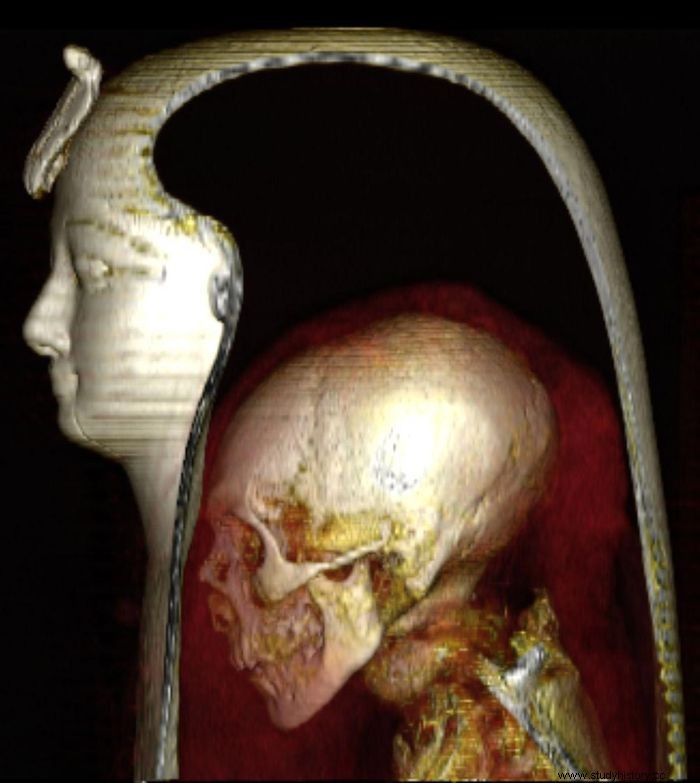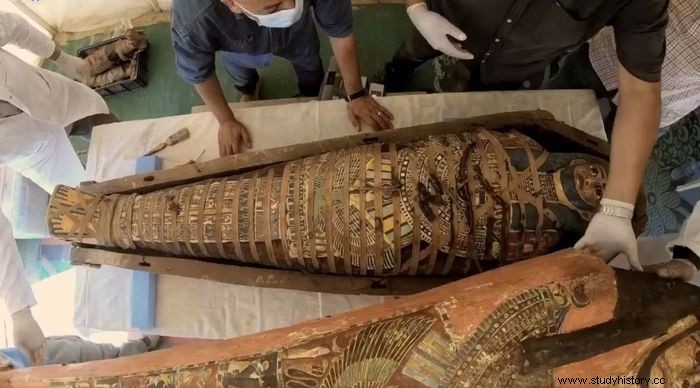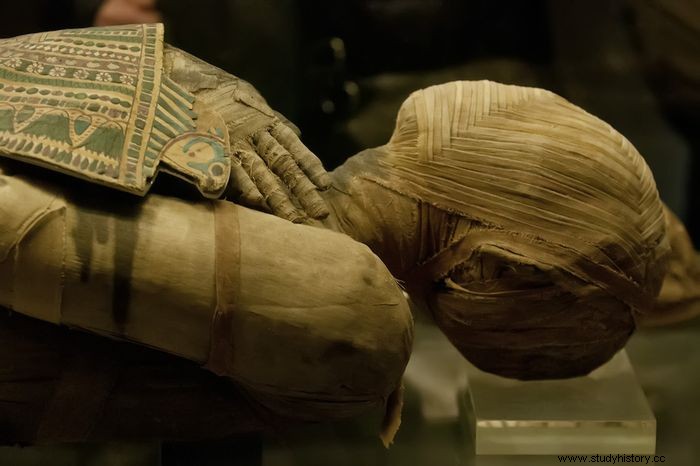Mummified bones of Egyptian monarchs, royalty and priests have long aroused the interest of people all over the world, and provided insight into this long-gone civilization. Mummies and sarcophagi arouse the interest of people to know what lies beneath them and explore the unknown. Everyone wants to open up the mummies and know about the Egyptian rulers who were mummified and what secret they carry with them. However, it was an impossible dream until today. Since the 11th century BC, scientists have mainly peeled a mummy for the first time. Using CT scans, scientists have digitally extracted Pharaoh Amenhotep I, who ruled from 1525 to 1504 BC
Hans is the only royal mummy that has not yet been unpacked in modern times. According to scans, the prince was 35 years old, 169 cm tall, circumcised and in good physical health when he died. Therefore, his death was most likely caused by natural causes.
Researchers examined the royal appearance, health, cause of death and mummification in a report published in Frontiers in Medicine. They used CT to analyze the mummy and created three-dimensional images of the head mask, the bandages and the almost unpackaged mummy. The mummy was well preserved.

Unpacks Amenhotep I
Researchers discovered that the royal mummy resembled his father physically, with a narrow chin, slightly narrow nose, curly hair and somewhat protruding upper teeth. Researchers stated that they could not find any wounds or malformations caused by disease to support the cause of death, apart from several post-mortem mutilations, apparently performed by grave thieves after his original burial. The early mummifiers had taken his bowels, but not his brain or heart.
Why did I not unpack Amenhotep earlier?
Amenhotep I, the second pharaoh of the 18th dynasty who took the throne after the death of his father Ahmose I, ruled in Egypt for about 21 years. Egyptologists believe Amenhotep I ruled with his mother, Ahmose-Nefertari. His name means "Amun is happy." During his reign, Amenhotep I ruled Egypt, started a war against Kush, and led an expedition to Libya. Amenhotep I's mummy was discovered in 1881 at Luxor's Deir el-Bahari Royal Cache, where the authorities of the 21st dynasty buried the mummies of various kings and nobles in the New Kingdom to protect them from grave thieves.
Egyptian mummies have long been associated with magical ideas due to Hollywood extravagances. As a result, they have become immortalized as mythical beings. However, that is not the case. According to scientists, Egyptologists have never been brave enough to uncover the mummy of Pharaoh Amenhotep I, but not for any legendary reason.
According to the researchers, the unpacking never happened. Instead, it is carefully wrapped, decorated with beautiful flower wreaths and covered with an exquisite lifelike mask inlaid with colorful stones on the face and neck.
Unpacks the mummy
The mummy of King Amenhotep I (18th dynasty, ca. 1525–1504 BC) was reburied in the Deir el-Bahari Royal Cache by priests from the 21st dynasty. The body was discovered completely wrapped in 1881, making it one of the rare royal mummies that has not been opened in modern times. Experts believed that non-invasive digital extraction using CT would provide information about the physical appearance, health, cause of death and mummification technique of King Amenhotep I's mummy. They used CT to analyze the mummy and created three-dimensional images of the head mask, the bandages and the almost unpackaged mummy. CT allowed the visibility of Amenhotep in his face, who died at the age of 35. There were no CT indications of pathological abnormalities or a cause of death, and the teeth showed insignificant wear.
The mummy is adorned with 30 amulets / jewelry, including a beaded metallic (most likely gold) belt. The mummy has various post-mortem injuries, most likely caused by grave thieves and treated by embalmers from the 21st dynasty. The transverse right forearm is packed separately, and is believed to be the earliest known New Kingdom mummy with crossed arms at the chest. The head mask is made of cardboard and has stone eyes inserted into it. The digital extraction of Amenhotep I's mummy using CT creates a once-in-a-lifetime chance to reveal the king's physical properties non-invasively, understand the mummification technique of the early 18th dynasty, and the reburial intervention style of 21st dynasty balsams.

Background
Amenhotep I ruled Egypt for about 21 years (around 1525–1504 BC). He was the second monarch of the 18th dynasty to take the throne after the death of his father, Ahmose I. Amenhotep's name means "Amun is happy." His throne name was Djeserkare, which means "Holy is the soul of Re." During his reign, Amenhotep defended Egypt's borders, leading campaigns for Kush and expeditions to Libya. Ruler I ruled calmly, concentrating on administrative organization and temple building. Amenhotep In its most prominent temples was the temple of Amun in Karnak, a temple in Nubia at. Sai, and structures in Upper Egypt at Elephantine, Kom Ombo, Abydos, and the Temple of Nekhbet. Amenhotep I was honored in Deir El Medina after his death.
The original tomb of the ruler has not yet been discovered in modern times. The mummy was discovered in 1881 at Luxor's Deir el-Bahari Royal Cache, where the authorities of the 21st dynasty buried the mummies of various New Kingdom kings and nobles to protect them from grave thieves. It was discovered encapsulated in a coffin. The hieroglyphic writings on the coffin, known as dolls, proved Amenhotep in his name and documented the repackaging of the mummy after grave robbers destroyed it. Amenhotep I's mummy was repackaged twice by priests from the 21st dynasty:once by Pinedjem I, the Theban High Priest of Amun, and again a decade later by his son Masarharta.
The mummy of Amenhotep I was brought from Deir el Bahari to Cairo shortly after the discovery, first to the Boulaq Museum and then to a palace in Giza (for Ismail Pasha). Eventually, the royal mummies, including those from Amenhotep I, were moved to Cairo's Egyptian Museum in Tahrir in 1902. Amenhotep I's mummy was one of the rare royal mummies that modern Egyptologists had not opened. Due to its excellent packaging, covered with wreaths and its beautiful face mask, Gaston Maspero, Egypt's director of antiques at the time, chose to leave the body intact. When Amenhotep In his tomb was examined, a preserved wasp was discovered, probably attracted to the scent of garlands and imprisoned.
CT study of the mummy
The wrapped mummy's 3D model allows for visualization of the many component layers, including the head mask, wrapping bandages and the mummy. In addition, the digital unpacking of the mummy revealed by peeling off virtual layers the mummy's exterior and interior, so we could analyze it in depth.
Amenhotep III's Mummy My face is oval, with sunken eyes and flat cheeks. The nose is thin, flat and small, and the upper teeth protrude slightly. The chin is slender with tiny ears and a piercing in the left lobule. A few curly locks of hair are visible on the back and sides of the head. Amenhotep In his mother is in a generally good state of preservation.
Age at death
Based on the closure of the epiphyses of all long bones and the morphology of the surface of the symphysis pubis, Amenhotep At the age of death is believed to be 35 years old.
Jewelry and amulets
The enveloped mummy of Amenhotep I has 30 amulets / jewelry.
Mask for the head
A piece of cardboard surrounds the wrapped mummy's head and neck and continues in a three-part wig to the middle of the chest in front and behind.

mummification
According to their beliefs, mummification was carried out in ancient Egypt for 30 centuries. It was to preserve the corpse from deterioration in preparation for the resurrection. The funeral ceremonies and mummification were different according to the age of the ancient Egyptian culture. The royal mummies of ancient Egypt are a valuable source of information for our understanding of mummification procedures. Through visualization of bone and soft tissue sections and various foreign materials and packaging, CT imaging can help determine the style of mummification.
The ancient Egyptians often exercised the brain by inserting an instrument through the nose and cracking the weak area of the anterior skull base. The brain was removed, and embalming ingredients were occasionally inserted into the skull. Exerebration attempts go back to the fourth dynasty. The CT images of Amenhotep in his mummy show that no attempt was made to remove the brain, which appears shrunk and fills the back of the skull. Other royal mummies from the government of Amenhotep I (late 17th to early 18th dynasties) have not been excavated. Sequence genres Taa II, Meritamun, Thutmose II, Thutmose III and Hatshepsut are among them.
Excerebration became popular later in the 18th dynasty, and the peak is said to have occurred during the Ptolemaic period. The ancient Egyptian balms also removed the internal organs through an abdominal incision to prevent bodily decay. In ancient Egypt, it was important to bind and wrap the mummified body with linen cloths for the embalming process. The bandage techniques of the mummy evolved during the ancient Egyptian civilization. To protect the body, embalmers used funeral items. The Book of the Dead, an ancient Egyptian text, outlined specific amulets and their location.
From the predynastic period onwards, Egyptian mummies received jewelry made from various materials made from shells and pearls to gold and jewels. Some of the most famous and exquisite jewelry was discovered on Tutankhamun's complete royal mummy. However, fewer jewelry items were discovered in royal bodies in New Kingdom that were discovered in stored tombs. Earlier CT scans of New Kingdom's royal mummies discovered in the two royal caches revealed Thutmose III (BC) wearing two golden bracelets hidden under the wrapper. The CT images in this study indicate a belt made of 34 gold beads placed directly on the lower back of Amenhotep In his corpse.
The wrapped mummy of Amenhotep I offers a once-in-a-lifetime opportunity to learn about the help of priests from the 21st dynasty during the reburial. It is believed that the reburial of Amenhotep I's mummy, embalming from the 21st dynasty, inserted two amulets under the linen ribbon that were meant to hide the anterior abdominal wall defect.
Amenhotep In his mother wears a mask. In ancient Egypt, mummy masks were used for an intricate burial process. They are often made of cardboard. The balsams also draped the mummy with wreaths of Delphinium Orientale, Sesbania Egyptiaca, Acacia Nilotica and Carmanthus Tinctorius. The magnificent reburial work that the priests of the 21st dynasty gave to Amenhotep in his mummy influenced Maspero's decision not to uncover the mummy or damage its uniqueness. The new kingdom's reburial project Removal and reuse of royal burial equipment by priests from the 21st dynasty was accused of removing and reusing royal burial equipment for the third interim kings.
Two coffins were for Thutmose I (18th dynasty) were reused for King Pinudjem I (21st dynasty) (2). However, this CT scan of Amenhotep I's corpse reveals how the Theban priests of the 21st dynasty painstakingly repaired Amenhotep I's royal mummified body and preserved or gave precious amulets and jewels. The digital unpacking can give us renewed faith in the generosity of the priests of the 21st dynasty who are burying the royal mummies again.
CT scan of King Amenhotep I
CT scanning is the diagnostic gold standard for examining mummies. Unfortunately, magnetic resonance imaging has little use for examining dry mummified residues since it primarily provides information about the location of mobile hydrogen inside the body. However, dual-energy CT scans may be used in the future to examine Amenhotep in its mummy.
Dual-energy CT scan uses two different energy levels, which can help identify and characterize embalming ingredients in the mummy. The specialized CT imaging approach used in digital extraction can be useful in paleo-anthropological and bio-archaeological studies of Egyptian mummies and mummies from other civilizations such as Peru. In addition, CT scans are increasingly used in forensic medicine. Researchers revealed previously unknown facts about his appearance and the rich, unique jewelry he was buried with behind the layers of wrapping.
According to deciphered hieroglyphs, the mummy was opened sometime in the 11th century BCE It happened more than four huge centuries after his mummification and burial process. Scholars believe, however, that the priests who renovated and reburied him did so to fix grave robbery damage and reuse royal burial equipment for future pharaohs.
the conclusion
The digital revelation of Amenhotep's mummy using CT to reveal the physical characteristics of the king, understands the non-invasive mummification method early in the 18th dynasty. It effectively detects and analyzes the reburial intervention made in the 21st dynasty. Earlier, the Egyptian priest Neswaiu had been digitally extracted. Neswaiu lived in the third century BC. in Thebes - today's Luxor - by the deity Montu. His ashes were donated to the Mediterranean Museum when it opened in 1928.
